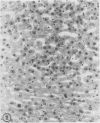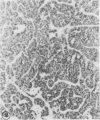Abstract
Alterations in DNA ploidy accompany hepatocellular carcinoma (HCC). However, changes in DNA content are also seen in regenerating liver and with increasing age. Thus, to investigate the role of DNA ploidy changes in development of HCC, flow cytometric DNA content determinations were done in a rat model system of peroxisome proliferator-induced HCC. Paraffin blocks of liver isolated from 18 Fisher 344 male rats fed ciprofibrate for 20 weeks (4), 40 weeks (4) or 20 months (10) were examined. Livers from age-matched control rats were also examined. From the 20 month ciprofibrate group, nine neoplastic nodules (NNs), 27 HCCs and four non-tumorous surrounding tissue controls (NTCs) were examined. Significant DNA tetraploid populations were seen in both the NNs and NTCs. A significant increase in the percentage of DNA diploid cells was observed in the NN samples. No significant difference in the percentage S-phase cells was seen. Emergence of cell populations with new DNA ploidy classes (8c or DNA aneuploid) as compared with NTCs was only seen in HCCs (7 of 27), and five of these seven were DNA aneuploid, as distinct from DNA tetraploid, populations. A total of 16 of 24 HCC samples that were adequate for cell cycle analysis had average percent S-phase greater than the mean of the NTCs plus three standard deviations. Although a direct role cannot be inferred, these results support the hypothesis that increases in the fraction of diploid cells is an important early event in the development of rat HCC and that further alterations in DNA ploidy and increased proliferative fraction accompany the development of HCC.
Full text
PDF





Images in this article
Selected References
These references are in PubMed. This may not be the complete list of references from this article.
- Arakawa M., Kage M., Sugihara S., Nakashima T., Suenaga M., Okuda K. Emergence of malignant lesions within an adenomatous hyperplastic nodule in a cirrhotic liver. Observations in five cases. Gastroenterology. 1986 Jul;91(1):198–208. doi: 10.1016/0016-5085(86)90458-0. [DOI] [PubMed] [Google Scholar]
- Becker F. F., Fox R. A., Klein K. M., Wolman S. R. Chromosome patterns in rat hepatocytes during N-2-fluorenylacetamide carcinogenesis. J Natl Cancer Inst. 1971 Jun;46(6):1261–1269. [PubMed] [Google Scholar]
- Becker F. F., Klein K. M., Wolman S. R., Asofsky R., Sell S. Characterization of primary hepatocellular carcinomas and initial transplant generations. Cancer Res. 1973 Dec;33(12):3330–3338. [PubMed] [Google Scholar]
- Carlson J., Abraham R. Nuclear ploidy of neonatal rat livers: effects of two hepatic carcinogens (mirex and dimethylnitrosamine). J Toxicol Environ Health. 1985;15(5):551–559. doi: 10.1080/15287398509530685. [DOI] [PubMed] [Google Scholar]
- Chen L. C., Neubauer A., Kurisu W., Waldman F. M., Ljung B. M., Goodson W., 3rd, Goldman E. S., Moore D., 2nd, Balazs M., Liu E. Loss of heterozygosity on the short arm of chromosome 17 is associated with high proliferative capacity and DNA aneuploidy in primary human breast cancer. Proc Natl Acad Sci U S A. 1991 May 1;88(9):3847–3851. doi: 10.1073/pnas.88.9.3847. [DOI] [PMC free article] [PubMed] [Google Scholar]
- Cho K. R., Vogelstein B. Genetic alterations in the adenoma--carcinoma sequence. Cancer. 1992 Sep 15;70(6 Suppl):1727–1731. doi: 10.1002/1097-0142(19920915)70:4+<1727::aid-cncr2820701613>3.0.co;2-p. [DOI] [PubMed] [Google Scholar]
- Danielsen H. E., Steen H. B., Lindmo T., Reith A. Ploidy distribution in experimental liver carcinogenesis in mice. Carcinogenesis. 1988 Jan;9(1):59–63. doi: 10.1093/carcin/9.1.59. [DOI] [PubMed] [Google Scholar]
- Digernes V. Chemical liver carcinogenesis: monitoring of the process by flow cytometric DNA measurements. Environ Health Perspect. 1983 Apr;50:195–200. doi: 10.1289/ehp.8350195. [DOI] [PMC free article] [PubMed] [Google Scholar]
- Farber E., Cameron R. The sequential analysis of cancer development. Adv Cancer Res. 1980;31:125–226. doi: 10.1016/s0065-230x(08)60658-2. [DOI] [PubMed] [Google Scholar]
- Friend S. H., Dryja T. P., Weinberg R. A. Oncogenes and tumor-suppressing genes. N Engl J Med. 1988 Mar 10;318(10):618–622. doi: 10.1056/NEJM198803103181007. [DOI] [PubMed] [Google Scholar]
- Goldsworthy T. L., Hanigan M. H., Pitot H. C. Models of hepatocarcinogenesis in the rat--contrasts and comparisons. Crit Rev Toxicol. 1986;17(1):61–89. doi: 10.3109/10408448609037071. [DOI] [PubMed] [Google Scholar]
- Haesen S., Derijcke T., Deleener A., Castelain P., Alexandre H., Préat V., Kirsch-Volders M. The influence of phenobarbital and butylated hydroxytoluene on the ploidy rate in rat hepatocarcinogenesis. Carcinogenesis. 1988 Oct;9(10):1755–1761. doi: 10.1093/carcin/9.10.1755. [DOI] [PubMed] [Google Scholar]
- Hedley D. W., Friedlander M. L., Taylor I. W., Rugg C. A., Musgrove E. A. Method for analysis of cellular DNA content of paraffin-embedded pathological material using flow cytometry. J Histochem Cytochem. 1983 Nov;31(11):1333–1335. doi: 10.1177/31.11.6619538. [DOI] [PubMed] [Google Scholar]
- Hoso M., Nakanuma Y. Cytophotometric DNA analysis of adenomatous hyperplasia in cirrhotic livers. Virchows Arch A Pathol Anat Histopathol. 1991;418(5):401–404. doi: 10.1007/BF01605925. [DOI] [PubMed] [Google Scholar]
- Klose U., Thierau D., Greim H., Schwarz L. R. Centrifugal elutriation of hepatocytes from 2-acetylaminofluorene-treated rats and their characterization by flow cytometry. Carcinogenesis. 1989 Mar;10(3):553–556. doi: 10.1093/carcin/10.3.553. [DOI] [PubMed] [Google Scholar]
- Koss L. G., Czerniak B., Herz F., Wersto R. P. Flow cytometric measurements of DNA and other cell components in human tumors: a critical appraisal. Hum Pathol. 1989 Jun;20(6):528–548. doi: 10.1016/0046-8177(89)90244-x. [DOI] [PubMed] [Google Scholar]
- Mori H., Tanaka T., Sugie S., Takahashi M., Williams G. M. DNA content of liver cell nuclei of N-2-fluorenylacetamide-induced altered foci and neoplasms in rats and human hyperplastic foci. J Natl Cancer Inst. 1982 Dec;69(6):1277–1282. [PubMed] [Google Scholar]
- Nowell P. C., Morris H. P., Potter V. R. Chromosomes of "minimal deviation" hepatomas and some other transplantable rat tumors. Cancer Res. 1967 Sep;27(9):1565–1579. [PubMed] [Google Scholar]
- Pitot H. C., Barsness L., Goldsworthy T., Kitagawa T. Biochemical characterisation of stages of hepatocarcinogenesis after a single dose of diethylnitrosamine. Nature. 1978 Feb 2;271(5644):456–458. doi: 10.1038/271456a0. [DOI] [PubMed] [Google Scholar]
- Pitot H. C., Sirica A. E. The stages of initiation and promotion in hepatocarcinogenesis. Biochim Biophys Acta. 1980 May 6;605(2):191–215. doi: 10.1016/0304-419x(80)90004-9. [DOI] [PubMed] [Google Scholar]
- Popp J. A., Marsman D. S. Chemically induced cell proliferation in liver carcinogenesis. Prog Clin Biol Res. 1991;369:389–395. [PubMed] [Google Scholar]
- Rabes H. M. Development and growth of early preneoplastic lesions induced in the liver by chemical carcinogens. J Cancer Res Clin Oncol. 1983;106(2):85–92. doi: 10.1007/BF00395384. [DOI] [PMC free article] [PubMed] [Google Scholar]
- Rao M. S., Lalwani N. D., Reddy J. K. Sequential histologic study of rat liver during peroxisome proliferator [4-chloro-6-(2,3-xylidino)-2-pyrimidinylthio]-acetic acid (Wy-14,643)-induced carcinogenesis. J Natl Cancer Inst. 1984 Oct;73(4):983–990. [PubMed] [Google Scholar]
- Rao M. S., Reddy J. K. An overview of peroxisome proliferator-induced hepatocarcinogenesis. Environ Health Perspect. 1991 Jun;93:205–209. doi: 10.1289/ehp.9193205. [DOI] [PMC free article] [PubMed] [Google Scholar]
- Rao M. S., Tatematsu M., Subbarao V., Ito N., Reddy J. K. Analysis of peroxisome proliferator-induced preneoplastic and neoplastic lesions of rat liver for placental form of glutathione S-transferase and gamma-glutamyltranspeptidase. Cancer Res. 1986 Oct;46(10):5287–5290. [PubMed] [Google Scholar]
- Reddy J. K., Rao S., Moody D. E. Hepatocellular carcinomas in acatalasemic mice treated with nafenopin, a hypolipidemic peroxisome proliferator. Cancer Res. 1976 Apr;36(4):1211–1217. [PubMed] [Google Scholar]
- Romagna F., Zbinden G. Distribution of nuclear size and DNA content in serial liver biopsies of rats treated with N-nitrosomorpholine, phenobarbital and butylated hydroxytoluene. Exp Cell Biol. 1981;49(6):294–305. doi: 10.1159/000163837. [DOI] [PubMed] [Google Scholar]
- STICH H. F. The DNA content of tumor cells. II. Alterations during the formation of hepatomas in rats. J Natl Cancer Inst. 1960 Jun;24:1283–1297. [PubMed] [Google Scholar]
- Sarafoff M., Rabes H. M., Dörmer P. Correlations between ploidy and initiation probability determined by DNA cytophotometry in individual altered hepatic foci. Carcinogenesis. 1986 Jul;7(7):1191–1196. doi: 10.1093/carcin/7.7.1191. [DOI] [PubMed] [Google Scholar]
- Scherer E. Neoplastic progression in experimental hepatocarcinogenesis. Biochim Biophys Acta. 1984;738(4):219–236. doi: 10.1016/0304-419x(83)90005-7. [DOI] [PubMed] [Google Scholar]
- Schwarze P. E., Pettersen E. O., Shoaib M. C., Seglen P. O. Emergence of a population of small, diploid hepatocytes during hepatocarcinogenesis. Carcinogenesis. 1984 Oct;5(10):1267–1275. doi: 10.1093/carcin/5.10.1267. [DOI] [PubMed] [Google Scholar]
- Steiner M. G., Harlow S. P., Colombo E., Bauer K. D. Chromosomes 8, 12, and 17 copy number in Astler-Coller stage C colon cancer in relation to proliferative activity and DNA ploidy. Cancer Res. 1993 Feb 1;53(3):681–686. [PubMed] [Google Scholar]
- Styles J. A., Kelly M., Pritchard N. R., Elcombe C. R. A species comparison of acute hyperplasia induced by the peroxisome proliferator methylclofenapate: involvement of the binucleated hepatocyte. Carcinogenesis. 1988 Sep;9(9):1647–1655. doi: 10.1093/carcin/9.9.1647. [DOI] [PubMed] [Google Scholar]
- Styles J., Elliott B. M., Lefevre P. A., Robinson M., Pritchard N., Hart D., Ashby J. Irreversible depression in the ratio of tetraploid:diploid liver nuclei in rats treated with 3'-methyl-4-dimethylaminoazobenzene (3'M). Carcinogenesis. 1985 Jan;6(1):21–28. doi: 10.1093/carcin/6.1.21. [DOI] [PubMed] [Google Scholar]
- Sudilovsky O., Hinrichsen L. I., Hei T. K., Whitacre C. M., Wang J. H., Kasturi S., Jiang S. H., Cechner R., Miron S., Abdul-Karim F. Genetic instability occurs sooner than expected: promotion, progression and clonality during hepatocarcinogenesis in the rat. Basic Life Sci. 1991;57:263–277. doi: 10.1007/978-1-4684-5994-4_23. [DOI] [PubMed] [Google Scholar]
- Terada T., Nakanuma Y. Iron-negative foci in siderotic macroregenerative nodules in human cirrhotic liver. A marker of incipient neoplastic lesions. Arch Pathol Lab Med. 1989 Aug;113(8):916–920. [PubMed] [Google Scholar]
- Thomas R. M., Berman J. J., Yetter R. A., Moore G. W., Hutchins G. M. Liver cell dysplasia: a DNA aneuploid lesion with distinct morphologic features. Hum Pathol. 1992 May;23(5):496–503. doi: 10.1016/0046-8177(92)90126-n. [DOI] [PubMed] [Google Scholar]
- Waldman F. M., Carroll P. R., Kerschmann R., Cohen M. B., Field F. G., Mayall B. H. Centromeric copy number of chromosome 7 is strongly correlated with tumor grade and labeling index in human bladder cancer. Cancer Res. 1991 Jul 15;51(14):3807–3813. [PubMed] [Google Scholar]
- Wang J. H., Hinrichsen L. I., Whitacre C. M., Cechner R. L., Sudilovsky O. Nuclear DNA content of altered hepatic foci in a rat liver carcinogenesis model. Cancer Res. 1990 Dec 1;50(23):7571–7576. [PubMed] [Google Scholar]
- Weisburger J. H., Yamamoto R. S., Williams G. M., Grantham P. H., Matsushima T., Weisburger E. K. On the sulfate ester of N-hydroxy-N-2-fluorenylacetamide as a key ultimate hepatocarcinogen in the rat. Cancer Res. 1972 Mar;32(3):491–500. [PubMed] [Google Scholar]
- Williams G. M. The pathogenesis of rat liver cancer caused by chemical carcinogens. Biochim Biophys Acta. 1980 May 6;605(2):167–189. doi: 10.1016/0304-419x(80)90003-7. [DOI] [PubMed] [Google Scholar]




